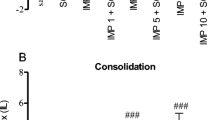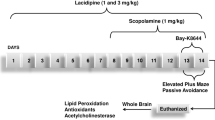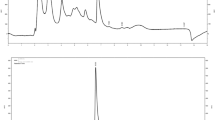Abstract
Objective
Minocycline, a semisynthetic tetracycline-derived antibiotic, has various pharmacological effect such as anti-inflammatory, anti-oxidative stress, and anti-apoptotic effects. The current study investigated the involvement of neuro-inflammatory, oxidative stress, and cholinergic markers in neuroprotection by minocycline against scopolamine-induced brain damage.
Methods
Minocycline was administered (oral, 10, 15, and 30 mg/kg, daily) to groups of amnesic rats for 21 days. Passive avoidance memory and spatial learning and memory were assessed. Following that, oxidative stress, cholinergic function, and neuro-inflammation markers were evaluated in the brain tissue.
Results
According to our biochemical data, treatment of the scopolamine-injured rats with minocycline decreased the levels of malondialdehyde and acetylcholinesterase (AChE) as well as mRNA expression of AChE and neuro-inflammation markers (tumor necrosis factor-α, interleukin (IL)-1β, IL-6). It also increased the total thiol levels and superoxide dismutase activity as well as mRNA expression of cholinergic receptor M1 (ChRM1). Moreover, minocycline modified distance and latencies in Morris water maze, prolonged latency to enter the black zone and light time while decreasing time spent and frequency of entries to darkness.
Conclusion
Taken together, the data indicate that treatment with minocycline improved memory dysfunction mediated possibly through restoring AChE and ChRM1 levels, oxidant/antioxidant balance, as well as inhibiting inflammatory responses.








Similar content being viewed by others
Data availability
The data that support the findings of this study are available from the corresponding author upon reasonable request.
References
Abdo Qaid EY, Abdullah Z, Zakaria R, Long I (2022) Minocycline protects against lipopolysaccharide-induced glial cells activation and oxidative stress damage in the medial prefrontal cortex (mPFC) of the rat. Int J Neurosci. https://doi.org/10.1080/00207454.2022.2084092
Akbarian M, Mirzavi F, Amirahmadi S, Hosseini M, Alipour M, Feizi H, Rajabian A (2022) Amelioration of oxidative stress, cholinergic dysfunction, and neuroinflammation in scopolamine-induced amnesic rats fed with pomegranate seed. Inflammopharmacology 30(3):1021–1035
Angelova PR, Esteras N, Abramov AY (2021) Mitochondria and lipid peroxidation in the mechanism of neurodegeneration: Finding ways for prevention. Med Res Rev 41(2):770–784
Cai Z, Zhao Y, Yao S, Zhao B (2011) Increases in β-amyloid protein in the hippocampus caused by diabetic metabolic disorder are blocked by minocycline through inhibition of NF-κB pathway activation. Pharmacol Rep 63(2):381–391
Chen WN, Yeong KY (2020) Scopolamine, a toxin-induced experimental model, used for research in Alzheimer’s disease CNS and neurological disorders-drug targets. Formerly Curr Drug Targets-CNS Neurol Disord 19(2):85–93
Chen S-D, Yin J-H, Hwang C-S, Tang C-M, Yang D-I (2012) Anti-apoptotic and anti-oxidative mechanisms of minocycline against sphingomyelinase/ceramide neurotoxicity: implication in Alzheimer’s disease and cerebral ischemia. Free Radical Res 46(8):940–950
Chen S-Y, Gao Y, Sun J-Y, Meng X-L, Yang D, Fan L-H, Xiang L, Wang P (2020) Traditional Chinese medicine: role in reducing β-amyloid, apoptosis, autophagy, neuroinflammation, oxidative stress, and mitochondrial dysfunction of Alzheimer’s disease. Front Pharmacol 11:497
Cheng X, Shen Y, Li R (2014) Targeting TNF: a therapeutic strategy for Alzheimer’s disease. Drug Discovery Today 19(11):1822–1827
Colovic M, Caccia S (2003) Liquid chromatographic determination of minocycline in brain-to-plasma distribution studies in the rat. J Chromatogr B Analyt Technol Biomed Life Sci 791(1–2):337–343
Garcez ML, Mina F, Bellettini-Santos T, Carneiro FG, Luz AP, Schiavo GL, Andrighetti MS, Scheid MG, Bolfe RP, Budni J (2017) Minocycline reduces inflammatory parameters in the brain structures and serum and reverses memory impairment caused by the administration of amyloid β (1–42) in mice. Prog Neuropsychopharmacol Biol Psychiatry 77:23–31
Gatta V, Mengod G, Reale M, Tata AM (2020) Possible correlation between cholinergic system alterations and neuro/inflammation in multiple sclerosis. Biomedicines 8(6):153
Gautieri A, Beeg M, Gobbi M, Rigoldi F, Colombo L, Salmona M (2019) The anti-amyloidogenic action of doxycycline: a molecular dynamics study on the interaction with Aβ42. Int J Mol Sci 20(18):4641
Hernández-Rodríguez M, Arciniega-Martínez IM, García-Marín ID, Correa-Basurto J, Rosales-Hernández MC (2020) Chronic administration of scopolamine increased GSK3βP9, beta secretase, amyloid beta, and oxidative stress in the hippocampus of wistar rats. Mol Neurobiol 57(9):3979–3988
Hooper SB, Kitchen MJ, Wallace MJ, Yagi N, Uesugi K, Morgan MJ, Hall C, Siu KK, Williams IM, Siew M (2007) Imaging lung aeration and lung liquid clearance at birth. FASEB J 21(12):3329–3337
Hosseini Z, Mansouritorghabeh F, Kakhki FSH, Hosseini M, Rakhshandeh H, Hosseini A, Hasanpour M, Iranshahi M, Rajabian A (2022) Effect of sanguisorba minor on scopolamine-induced memory loss in rat: involvement of oxidative stress and acetylcholinesterase. Metab Brain Dis 37(2):1–16
Kim JH, He MT, Kim MJ, Yang CY, Shin YS, Yokozawa T, Park CH, Cho EJ (2019) Safflower (Carthamus tinctorius L) seed attenuates memory impairment induced by scopolamine in mice via regulation of cholinergic dysfunction and oxidative stress. Food Funct 10(6):3650–3659
Kim M-J, Hwang E-S, Kim KJ, Maeng S, Heo HJ, Park J-H, Kim D-O (2021) Anti-amnesic effects of epigallocatechin gallate on scopolamine-induced learning and memory dysfunction in Sprague-Dawley rats. Antioxidants 11(1):1
Kohman RA, Bhattacharya TK, Kilby C, Bucko P, Rhodes JS (2013) Effects of minocycline on spatial learning, hippocampal neurogenesis and microglia in aged and adult mice. Behav Brain Res 242:17–24
Mastrogiovanni F, Mukhopadhya A, Lacetera N, Ryan MT, Romani A, Bernini R, Sweeney T (2019) Anti-inflammatory effects of pomegranate peel extracts on in vitro human intestinal Caco-2 cells and Ex vivo porcine colonic tissue explants. Nutrients 11(3):548
Mehta BK, Banerjee S (2019) Minocycline reverses diabetes-associated cognitive impairment in rats. Pharmacol Rep 71(4):713–720
Metz LM, Zhang Y, Yeung M, Patry DG, Bell RB, Stoian CA, Yong VW, Patten SB, Duquette P, Antel JP (2004) Minocycline reduces gadolinium-enhancing magnetic resonance imaging lesions in multiple sclerosis. Ann Neurol 55(5):756–756
Naderi Y, Panahi Y, Barreto GE, Sahebkar A (2020) Neuroprotective effects of minocycline on focal cerebral ischemia injury: a systematic review. Neural Regen Res 15(5):773
Romero-Miguel D, Lamanna-Rama N, Casquero-Veiga M, Gómez-Rangel V, Desco M, Soto-Montenegro ML (2021) Minocycline in neurodegenerative and psychiatric diseases: an update. Eur J Neurol 28(3):1056–1081
Schneider L, Reichert E, Faulkner J, Reichert B, Sonnen J, Hawryluk GW (2019) CNS inflammation and neurodegeneration: sequelae of peripheral inoculation with spinal cord tissue in rat. J Neurosurg 132(3):933–944
Shabab T, Khanabdali R, Moghadamtousi SZ, Kadir HA, Mohan G (2017) Neuroinflammation pathways: a general review. Int J Neurosci 127(7):624–633
Shabani S, Mirshekar MA (2018) Diosmin is neuroprotective in a rat model of scopolamine-induced cognitive impairment. Biomed Pharmacother 108:1376–1383
Verma DK, Singh DK, Gupta S, Gupta P, Singh A, Biswas J, Singh S (2018) Minocycline diminishes the rotenone induced neurotoxicity and glial activation via suppression of apoptosis, nitrite levels and oxidative stress. Neurotoxicology 65:9–21
Wang X, Zhang D, Song W, Cai CF, Zhou Z, Fu Q, Yan X, Cao Y, Fang M (2020) Neuroprotective effects of the aerial parts of Polygala tenuifolia Willd extract on scopolamine-induced learning and memory impairments in mice. Biomedical Reports 13(5):1–1
Zhu S-Z, Huang W-P, Huang L-Q, Han Y-L, Han Q-P, Zhu G-F, Wen M-Y, Deng Y-Y, Zeng H-K (2016) Huperzine A protects sepsis associated encephalopathy by promoting the deficient cholinergic nervous function. Neurosci Lett 631:70–78
Acknowledgements
Research reported in this publication was supported by Elite Researcher Grant Committee under award number [4000373] from the National Institute for Medical Research Development (NIMAD), Tehran, Iran.
Funding
This project was financially supported by National Institute for Medical Research Development (Grant no: 4000373).
Author information
Authors and Affiliations
Contributions
SA, MA, FM, FDF, MHEG, and AR performed the experiments. MH and AR designed the study and prepared a draft of the manuscript. All authors have read and approved the final version of the manuscript.
Corresponding authors
Ethics declarations
Conflict of interest
The authors declare that they have no conflict interests.
Additional information
Publisher's Note
Springer Nature remains neutral with regard to jurisdictional claims in published maps and institutional affiliations.
Rights and permissions
Springer Nature or its licensor holds exclusive rights to this article under a publishing agreement with the author(s) or other rightsholder(s); author self-archiving of the accepted manuscript version of this article is solely governed by the terms of such publishing agreement and applicable law.
About this article
Cite this article
Amirahmadi, S., Farimani, F.D., Akbarian, M. et al. Minocycline attenuates cholinergic dysfunction and neuro-inflammation-mediated cognitive impairment in scopolamine-induced Alzheimer’s rat model. Inflammopharmacol 30, 2385–2397 (2022). https://doi.org/10.1007/s10787-022-01071-2
Received:
Accepted:
Published:
Issue Date:
DOI: https://doi.org/10.1007/s10787-022-01071-2




